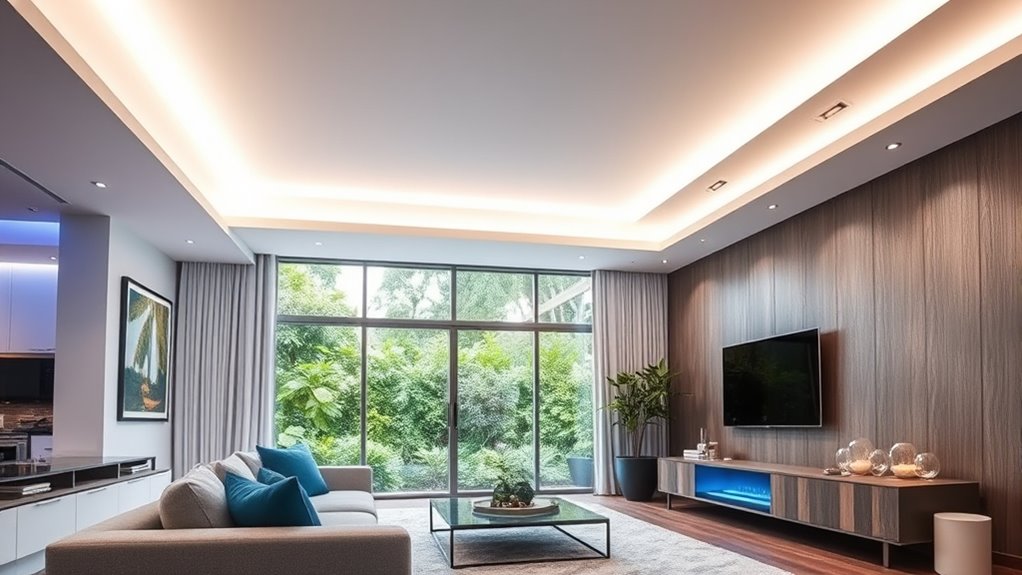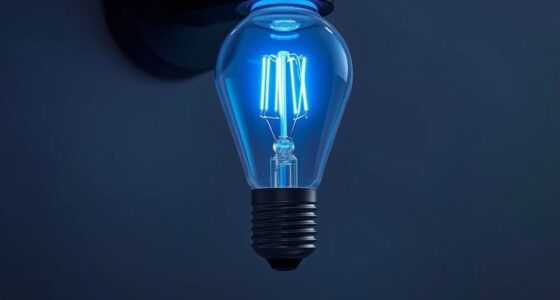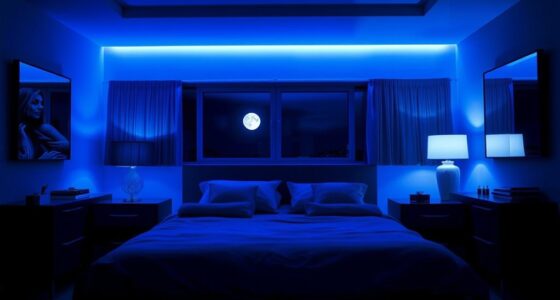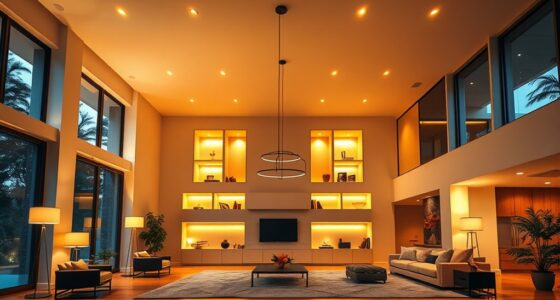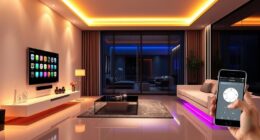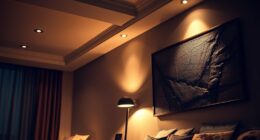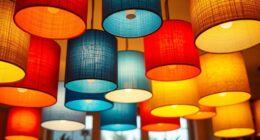Energy-efficient LED innovations now make your lighting more sustainable and cost-effective. Smart controls let you manage brightness, schedules, and scenes remotely, optimizing energy use without sacrificing comfort. High-quality LEDs also offer improved color rendering, creating vibrant, natural environments. These advancements help you reduce your carbon footprint while enjoying better ambiance. By embracing these trends, you support a greener future—continue exploring to discover how these cutting-edge features can transform your space.
Key Takeaways
- Smart controls enable remote management, scheduling, and automatic adjustments to optimize energy efficiency and reduce waste.
- Advances in LED technology improve color rendering, creating vibrant, true-to-life visuals while maintaining low energy consumption.
- Integration of energy-saving features and automation supports sustainability goals by lowering electricity use and extending fixture lifespan.
- Future trends include more accessible, affordable intelligent lighting systems that combine efficiency with enhanced visual satisfaction.
- Overall, innovations promote environmentally friendly lighting solutions that balance performance, aesthetics, and energy conservation.

As technology advances, LED lighting continues to become more energy-efficient, offering significant savings and environmental benefits. One of the most exciting innovations in this space is the integration of smart controls. These allow you to manage your lighting with ease, using apps, voice commands, or automated schedules. With smart controls, you can turn lights on or off remotely, adjust brightness, and even customize lighting scenes based on your activity or mood. This level of control helps you reduce unnecessary energy consumption, since you’re only using light when needed and at ideal levels. Plus, many smart LED systems learn your habits over time, automatically adjusting to save energy without sacrificing comfort. This seamless integration of technology not only enhances convenience but also maximizes efficiency, making your lighting setup smarter and more sustainable. Energy‑saving features are a key focus in modern LED innovations, further amplifying their environmental impact.
Another key aspect of these innovations is improved color rendering. High-quality LED lights now offer superior color rendering capabilities, which means they produce more natural and vibrant colors. This is especially important if you work in environments where accurate color representation matters, like art studios, retail spaces, or even your home. Better color rendering ensures that the objects, paints, or textiles you see are true to life, reducing the need for additional lighting or adjustments. It also enhances the ambiance of your space, making it more inviting and visually appealing. As LED technology advances, manufacturers are focusing on increasing the color rendering index (CRI), which measures how well a light source displays colors compared to natural light. Higher CRI levels translate to a more realistic and pleasant visual experience, all while maintaining energy efficiency. This means you don’t have to compromise on quality or aesthetics to conserve energy.
Combining smart controls with high color rendering capabilities creates a lighting environment that’s both efficient and visually satisfying. You can set your LEDs to adjust automatically based on the time of day or specific tasks, ensuring you always have the right lighting without wasting energy. For example, during the day, you might prefer bright, natural-looking light, while in the evening, softer, warmer tones could create a cozy atmosphere. These innovations also contribute to sustainability by reducing electricity consumption and extending the lifespan of your LED fixtures. As more companies adopt these advancements, expect to see even more intelligent, color-accurate, and environmentally friendly lighting options becoming accessible and affordable for everyone. You’re not just upgrading your space; you’re contributing to a greener future with smarter, better lighting solutions.
Frequently Asked Questions
How Do LED Lights Compare to Traditional Lighting in Lifespan?
You’ll find that LED lights have a considerably longer lifespan compared to traditional lighting. They typically last 25,000 to 50,000 hours, offering greater longevity and reducing replacement costs. When it comes to cost comparison, although LEDs may have a higher upfront price, their durability and energy efficiency save you money over time. Overall, LEDs provide a smarter, more sustainable lighting option with extended lifespan and lower long-term costs.
Are Energy-Efficient LEDS Cost-Effective Long-Term Investments?
Yes, energy-efficient LEDs are a cost-effective long-term investment. Although their initial costs are higher, you save substantially on energy bills due to their low power consumption. Plus, LEDs last much longer, reducing replacement costs and maintenance. Over time, these cost savings outweigh the initial investment, making LEDs a smart choice for sustainable lighting. You’ll enjoy both environmental benefits and financial savings with these innovative, energy-efficient lights.
What Are the Environmental Impacts of LED Manufacturing?
You should know that LED manufacturing impacts the environment mainly through manufacturing emissions and material sustainability concerns. The process emits greenhouse gases and consumes energy, contributing to climate change. Additionally, sourcing materials like rare earth elements raises sustainability issues, as mining can harm ecosystems. To minimize these impacts, companies are adopting greener manufacturing practices and focusing on recyclable materials, helping reduce the environmental footprint of LED production.
Can LEDS Be Recycled Easily After Their Lifespan?
Imagine your LED as a treasure chest, waiting to be opened. You can recycle LEDs easily after their lifespan through specialized recycling processes. These processes allow for material recovery, extracting valuable components like metals and plastics. Proper recycling reduces waste and conserves resources, turning old LEDs into new treasures. So yes, with the right methods, LEDs can be efficiently recycled, helping you contribute to a more sustainable future.
How Do LED Innovations Influence Smart Home Integration?
LED innovations greatly influence your smart home integration by enabling seamless smart home automation. With advanced wireless connectivity, you can control your LED lighting remotely via smartphones or voice commands. These innovations allow your lights to sync with your security systems, adjust based on your routines, and improve energy efficiency. As a result, you enjoy greater convenience, customization, and smarter energy management, making your home more comfortable and eco-friendly.
Conclusion
By embracing brilliant breakthroughs in LED technology, you can brighten your space while lowering your carbon footprint. These innovative, energy-efficient LED solutions spark sustainability, save superfluous spending, and shine a spotlight on smarter, more sustainable lighting trends. So, seize the chance to switch, save, and shine brighter—because sustainable lighting isn’t just smart, it’s essential. Let these luminous innovations lead you toward a greener, glowier future that benefits both your home and the planet.
